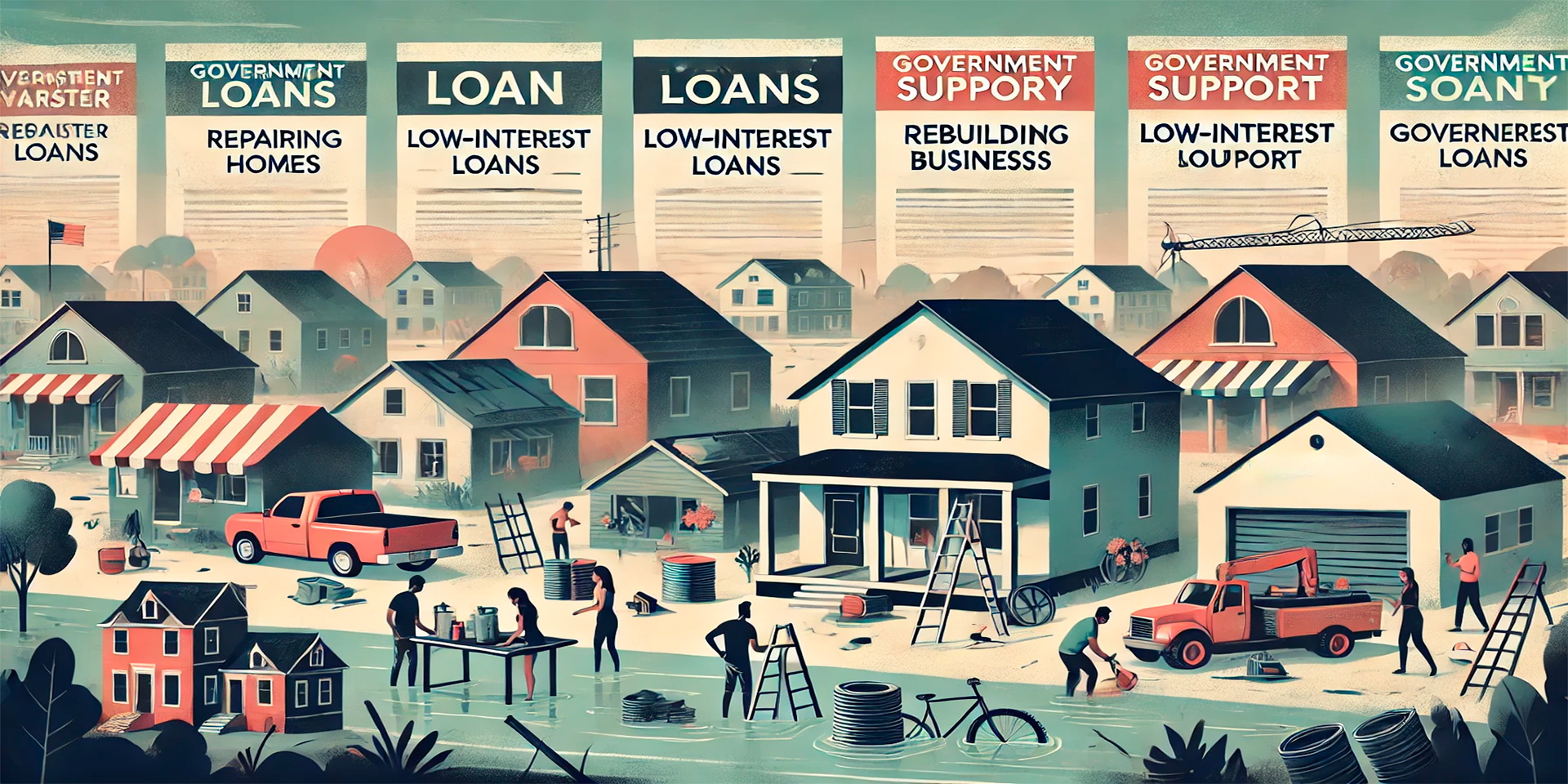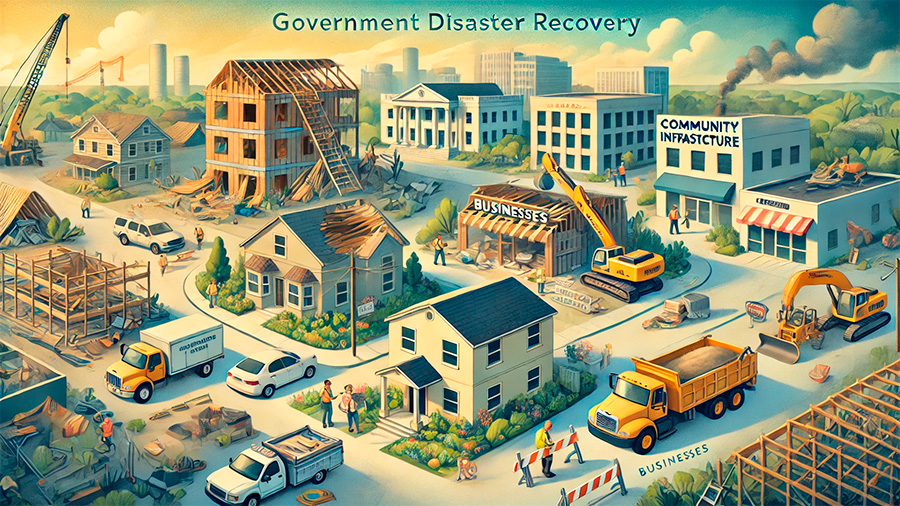Rebuilding After a Disaster: How Government Loans Help You Recover

When severe weather strikes, the damage can be overwhelming for individuals, businesses, and communities. Recovering from a natural disaster often requires significant financial resources to repair homes, rebuild businesses, and restore livelihoods. Fortunately, government disaster loans provide vital support for those affected by weather-related events, offering low-interest financing to help cover the costs of recovery.
This article explores how government disaster loans play a crucial role in financing post-disaster recovery, the types of loans available, and how to apply for financial assistance.
Understanding Government Disaster Loans
Government disaster loans are designed to provide financial assistance to individuals, businesses, and communities that have been impacted by natural disasters such as hurricanes, floods, wildfires, and tornadoes. These loans are typically offered at low interest rates and are intended to help cover the costs of repairing property, replacing equipment, and rebuilding infrastructure. The primary goal of these loans is to ensure that those affected by disasters have access to the funds they need to recover and rebuild.
1. Low-Interest Financing for Recovery
One of the main benefits of government disaster loans is the low-interest rate compared to traditional loans. This makes it easier for borrowers to manage their repayment while focusing on recovery efforts. These loans are often extended for long-term periods, allowing individuals and businesses to rebuild without facing immediate financial pressure.
Benefits of low-interest disaster loans:
- Affordable financing: Government loans typically come with lower interest rates than private loans, reducing the cost of borrowing.
- Flexible repayment terms: Borrowers have access to extended repayment periods, allowing them to recover without undue financial stress.
2. Broad Eligibility for Assistance
Government disaster loans are available to a wide range of individuals and entities, including homeowners, renters, businesses, and non-profit organizations. This broad eligibility ensures that various sectors of the community can access the financial support needed to recover from the effects of a natural disaster. Whether you need to repair your home, replace lost personal belongings, or rebuild a damaged business, there is likely a government loan option that suits your needs.
Who is eligible for disaster loans:
- Homeowners and renters: Individuals whose primary residences have been damaged or destroyed by a disaster may qualify for loans to repair or replace their homes and belongings.
- Businesses and non-profits: Businesses affected by disasters can apply for loans to repair facilities, replace equipment, and cover operating expenses during recovery.

Types of Government Disaster Loans
There are several types of government disaster loans available, each designed to meet the unique needs of individuals, businesses, and communities affected by natural disasters. These loans are offered through agencies such as the Small Business Administration (SBA) and the Federal Emergency Management Agency (FEMA).
1. SBA Disaster Loans
The Small Business Administration (SBA) is a key provider of disaster loans, offering financial assistance to both businesses and individuals. SBA disaster loans come in several forms, including loans for physical damage to property and loans for economic injury resulting from business disruptions.
SBA disaster loan categories:
- Home and Personal Property Loans: Low-interest loans for homeowners and renters to repair or replace damaged property, including personal belongings, vehicles, and furnishings.
- Business Physical Disaster Loans: Loans for businesses to repair or replace damaged real estate, equipment, inventory, and other business assets.
- Economic Injury Disaster Loans (EIDL): Loans to cover lost revenue and operating expenses for businesses impacted by a disaster, even if no physical damage occurred.
2. FEMA Disaster Assistance
In addition to the SBA, the Federal Emergency Management Agency (FEMA) offers disaster assistance to individuals and households affected by natural disasters. While FEMA primarily provides grants for immediate emergency needs, it also collaborates with other federal agencies to offer long-term recovery loans through programs like the Individual Assistance Program.
FEMA’s role in disaster recovery loans:
- Temporary housing grants: FEMA provides grants to cover temporary housing needs while more permanent repairs are being made.
- Collaborative recovery loans: FEMA partners with agencies like the SBA to provide low-interest loans for home repairs and rebuilding efforts.

How Government Disaster Loans Help with Post-Disaster Recovery
Government disaster loans are designed to address the specific financial challenges that arise after a natural disaster. From covering immediate repairs to restoring economic activity in affected areas, these loans are an essential part of the recovery process. Below are some of the key ways government loans help individuals and businesses rebuild after severe weather events.
1. Rebuilding Homes and Property
For homeowners and renters, the damage caused by natural disasters can be extensive, often leaving properties uninhabitable. Government disaster loans provide the necessary funds to repair or rebuild damaged homes, ensuring that individuals and families can return to safe, secure living conditions. These loans may also cover the replacement of personal belongings such as clothing, furniture, and appliances lost in the disaster.
How government loans support home recovery:
- Home repairs: Loans cover the cost of repairing structural damage, making homes safe to live in again.
- Personal property replacement: Funds are available to replace essential belongings damaged or destroyed in the disaster.
2. Restoring Businesses and Economic Activity
Disasters can have a devastating impact on local economies, particularly when businesses are forced to close due to damage or loss of revenue. Government disaster loans help businesses recover by covering the costs of repairing facilities, replacing damaged equipment, and compensating for lost revenue. By providing businesses with the financial resources needed to reopen, these loans play a vital role in restoring economic activity in disaster-affected areas.
How government loans support business recovery:
- Repairing business facilities: Loans help businesses cover the cost of repairing or rebuilding damaged commercial properties.
- Economic injury recovery: Loans can be used to cover lost revenue and operating expenses while businesses recover from the disaster.
3. Supporting Community Infrastructure
In addition to individual loans for homes and businesses, government disaster loans also provide funding for rebuilding community infrastructure. This includes the repair of roads, bridges, utilities, and public facilities that are essential for the functioning of a community. These loans help ensure that critical services can be restored quickly, allowing residents and businesses to return to normalcy.
How loans support community infrastructure recovery:
- Restoring public facilities: Loans help repair schools, hospitals, and other public facilities that are vital to community wellbeing.
- Infrastructure repair: Funding is provided for the repair of roads, bridges, and utilities that are necessary for transportation and public services.
How to Apply for Government Disaster Loans
Applying for a government disaster loan is a straightforward process, but it’s essential to act quickly following a disaster to ensure timely access to financial assistance. Below are the steps you need to take to apply for government disaster loans.
1. Register with FEMA
The first step in accessing disaster assistance is to register with FEMA. This can be done online, by phone, or in person at a Disaster Recovery Center. FEMA will assess your eligibility for various forms of assistance, including grants and loans, and may refer you to the SBA for further loan options if needed.
Steps to register with FEMA:
- Online registration: Visit the FEMA website to complete the registration process.
- Phone registration: Call FEMA’s helpline to speak with a representative and begin your application.
2. Apply for an SBA Loan
If you are referred to the SBA for disaster loan assistance, you will need to complete a loan application either online or in person. The application process typically requires documentation of the damage, proof of ownership, and financial records. Once submitted, the SBA will review your application and determine your eligibility for a loan.
Steps to apply for an SBA disaster loan:
- Complete the application: Submit an online or paper application for the appropriate SBA disaster loan.
- Provide required documentation: Include proof of damage, ownership, and financial records to support your application.
3. Review and Approval Process
After submitting your application, the SBA will conduct an evaluation to determine whether you qualify for a loan. This process may include a site inspection of the damaged property and a review of your financial ability to repay the loan. If approved, the SBA will work with you to determine the loan amount and establish repayment terms that fit your financial situation.
Loan approval process:
- Site inspection: SBA inspectors may visit the damaged property to assess the extent of the damage before approving the loan.
- Financial review: The SBA will review your credit history and financial ability to ensure that you can manage the loan repayment.
Conclusion
Government disaster loans provide essential financial support to help individuals, businesses, and communities recover after severe weather events. Whether you need to rebuild your home, restore your business, or repair critical infrastructure, these loans offer the low-interest financing necessary to get back on your feet. By understanding the types of disaster loans available and how to apply, you can ensure that you have access to the funds you need to move forward after a natural disaster.


